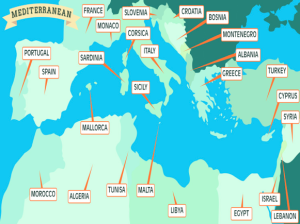What is the Mediterranean Diet?
 The Mediterranean diet is plant-based, relying primarily on fruits, vegetables, whole grains, nuts, and seeds, though this approach has a few animal products thrown in occasionally.The Mediterranean diet is also minimally-processed, using many foods in their whole and natural states. You won’t find a lot of added sugars, salt, or chemicals in the mix.But what foods does it feature, exactly? Let’s analyze each food group and see…Vegetables:The vegetables that make up most of the Mediterranean diet include garlic, eggplant, tomatoes, peppers, greens, fennel, and sweet peppers. Herbs and spices are very common too.Fruit:Lemons, oranges, grapes, and apricots are all common fruits in the Mediterranean diet. Dried fruits also play a key role.Grains:Grain foods vary by region, with some areas relying on couscous, others on rice, and still others on pasta. Breads also play a role. Choose whole grains when you can.Protein:The Mediterranean diet features many legumes, nuts, and seeds, all of which are wonderful sources of plant-based protein. When it comes to animal protein, fish and poultry top the list, though usually in small servings. The people who eat a Mediterranean diet typically consume no more than 12-16 ounces of red meat per month. Americans, on the other hand, eat an average of 4.5 ounces of red meat per day!Dairy:Let’s end our food group discussion with dairy. The Mediterranean diet features low to moderate use of cheese and yogurt. Cheese is very flavorful, but it's used in smaller amounts than in most American recipes. Dairy foods just aren’t big players here.Mediterranean Dining and Exercise Habits:The Mediterranean diet is comprised of several small meals throughout the day, rather than one or two large ones. The meals themselves can often be served tapas-style, with a bunch of small plates of food being shared.The Mediterranean lends itself to an active lifestyle, and indeed most people who live in the region get lots of daily physical activity. One study showed that the people of Crete got 4 times the amount of exercise as a typical American.
The Mediterranean diet is plant-based, relying primarily on fruits, vegetables, whole grains, nuts, and seeds, though this approach has a few animal products thrown in occasionally.The Mediterranean diet is also minimally-processed, using many foods in their whole and natural states. You won’t find a lot of added sugars, salt, or chemicals in the mix.But what foods does it feature, exactly? Let’s analyze each food group and see…Vegetables:The vegetables that make up most of the Mediterranean diet include garlic, eggplant, tomatoes, peppers, greens, fennel, and sweet peppers. Herbs and spices are very common too.Fruit:Lemons, oranges, grapes, and apricots are all common fruits in the Mediterranean diet. Dried fruits also play a key role.Grains:Grain foods vary by region, with some areas relying on couscous, others on rice, and still others on pasta. Breads also play a role. Choose whole grains when you can.Protein:The Mediterranean diet features many legumes, nuts, and seeds, all of which are wonderful sources of plant-based protein. When it comes to animal protein, fish and poultry top the list, though usually in small servings. The people who eat a Mediterranean diet typically consume no more than 12-16 ounces of red meat per month. Americans, on the other hand, eat an average of 4.5 ounces of red meat per day!Dairy:Let’s end our food group discussion with dairy. The Mediterranean diet features low to moderate use of cheese and yogurt. Cheese is very flavorful, but it's used in smaller amounts than in most American recipes. Dairy foods just aren’t big players here.Mediterranean Dining and Exercise Habits:The Mediterranean diet is comprised of several small meals throughout the day, rather than one or two large ones. The meals themselves can often be served tapas-style, with a bunch of small plates of food being shared.The Mediterranean lends itself to an active lifestyle, and indeed most people who live in the region get lots of daily physical activity. One study showed that the people of Crete got 4 times the amount of exercise as a typical American.


